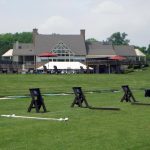Speed of play on the golf course is an important concern for when you want to provide a great experience for members and guests at your golf course. Some people like to keep moving when playing a round of golf, while others move slowly. How long is long enough for a round of golf? Don’t let your guests and members be disenchanted when the are caught behind a group of slow golfers on your course. Follow these tips to improve the speed of play on your golf course.
Important insight on increasing the speed of play from a golf insider.
This article is republished with the permission of the author Andrew Wood from Legendary Marketing. Originally published on March 21, 2015. Please visit http://www.golfoperatorsassociation.com
How to Increase the Speed of Play
Of the myriad of excuses people are making for the decline of golf slow play is the one I think that is most valid. It’s a problem that has been around a long time but is exasperated in todays go go society. For example when describing the length of the Sunday round at the 1983 Kemper Open, former CBS announcer Ben Wright said “See those ducks? They were mere eggs at the beginning of today.”
Things have only gotten worse in the three decades since then and while the USGA and PGA have frequent meetings on the subject they are as much of the problem as anyone.
Talk is cheap!
Ironically, given the fact the USGA has recently hosted back-to-back symposiums on slow play one would wonder how many times the association has ever penalized players for slow play in its biggest event—the U.S. Open?
It has done so just twice. Both players who fell foul are not exactly household names—Robert Impaglia for two strokes at the 1978 Open at Cherry Hills and Edward Fryatt at the 2007 Open at Congressional.
The last time a PGA Tour event slapped a two-stroke penalty for slow play was back in 1995 at Honda Classic when Glen Day—nicknamed “all day” because of his tortoise movements—was penalized. Playing on perfectly manicured courses, with hundreds of people to help find their ball, how can it take the world’s best players five hours or more to complete a round in a threesome?
For me speed of play has always been an issue;
Golf has always been too slow. I like to play fast. In fact, I once played a tournament round, walking, in one hour fifty nine minutes and shot 71, going through 6 groups in the process!
As recently as 2008 playing in the English amateur at Royal St Georges, where the rough stood shoulder height my group had a run in with an EGU official in his best blue blazer. He made the mistake of telling us on the 12th tee that we were a hole behind the group in front who had just left the 13th green and that would be penalized. My playing partner a short, tattooed, Popeye-armed guy from the East end of London, none too happy after losing a ball on the previous hole, got about an inch from the officials face and pointed out in no uncertain terms that “We had already played through five $#%& groups and he ought to look at his $#%& sheet before threatening players with penalties!”
I thought the guy was going to have a stroke. We went through the group in front two holes later and finished in 3.30, but fast rounds are the exception not the rule!
Time is a huge issue for today’s players and you have to be brutal about how to manage it at your club. The vast majority of members or players who pay rack rate don’t want to be out there for five or even four hours.
Meanwhile the seniors group may well enjoy their day more the longer they stay on the course, as it keeps them out of the house.
I hate seeing signs that say, “We are a 4.15 golf course.”
My last private club was a “4.20 club”
What the hell is wrong with playing golf in 3 hours? There is just no reason not to play in three hours in a golf cart, none!
But You Have to Set the Expectation!
The vast majority of golf clubs are far too timid about slow play, as are the PGA Tour, USGA and the R & A. So afraid of offending the offenders they choose instead to talk about the issue without doing anything other than the VERY occasional penalty on a C named player!
It takes balls, brass balls, but clubs need to be much more up front about their pace of play policy and guarantee rounds in under four hours. It can be done. Not everywhere but most places!
Set the expectation in your marketing messages:
Play in under 4 hours!
On your website, blog, flyers, ands, brochures and Facebook page.
Set up the expectation with your auto reply to a tee time booking:
Send an auto responder that outlines your speed of play policy and offer tips for its successful accomplishment!
“Thanks for booking your tee time at beautiful Legendary Country Club
“We are looking forward to seeing you and you getting round in less than four hours so you can play more holes, drink more beer or catch up with the family!
“We guarantee all our players a round in under four hours. In order to help with this please review the following and pass it along to those in your group who might need a little pre-round prod!”
For example:
16 Tips to Speed up Play and Enjoy Your Day
- Be early for your tee time. Proper pace of play begins with teeing off at the appointed time. Allow time for traffic, unloading your equipment, putting on your golf shoes, any desired practice or warm-up, purchasing any refreshments or balls and driving your cart to the first tee.
- “Tee It Forward” unless you are consistently able to reach greens in regulation from the back tees. In other words, play from a set of tees that is comfortable for you – one where you are more likely to hit lofted irons into greens instead of hybrids or fairway woods. It is acceptable for players in the same group to play from different tees.
- Be helpful to others in your group. Follow the flight of all tee shots, not just your own. Once in the fairway, help others look for their ball if you already know the location of yours. Volunteer to fill in a divot or rake a bunker for another player if needed. Be ready to attend the flagstick for others.
- Plan your shot while walking to your ball or while others are playing. Carry extra tees, ball markers and an extra ball in your pockets so you never have to return to your bag to find one when needed.
- Line up your putt when others are putting and be ready to play when it is your turn.
- Play ready golf first on the tee hits, not first in the hole!
- Walk directly to your golf ball; don’t follow others unless assisting in search.
- When two players are riding in a cart, drive the cart to the first ball and drop off the first player with his choice of several clubs. The second player should proceed in the cart to his ball. After the first player hits his stroke, he should begin walking toward the cart as the second golfer is playing.
- Don’t step off or measure yardage for every single golf shot, develop an “eye” for distance.
- Be efficient with your pre-shot routine. Take only one practice swing.
- Play a provisional ball if you think the original might be lost outside a water hazard or out of bounds.
- When hitting a shot from the bunker, make sure you put the rake next to you. That way you’ll be ready to rake right after you nestle your shot next to the cup.
- Park the cart at greenside as near as possible to where you expect to exit the green after holing out or if walking leave your clubs on the side of the putting green towards to next tee. This avoids backtracking.
- Exit putting green promptly after holing out. Wait until you’re on the next tee to start writing down scores.
- Don’t ask your playing partners to help you search for a lost ball – unless you are absolutely certain there is time for them to do so (e.g., there is no group behind waiting). If the course is crowded, your partners should continue moving forward, not slow things down further by stopping to help your search.
- Let them play through: If the group behind you is faster, it’s okay to let them play through. Finish your hole and then let them tee off ahead of you. It’s not a sign of weakness.
We look forward to seeing you, remember to forward this to your group so we are all working out of the same playbook.
Your Friendly
3.30 or less PGA pro
Obviously you could edit this message down to suit your specific needs but it covers most of the bases.
Set the expectation at check in:
“Sir, we promise our customers a round in under four hours and most like to finish in 3.30 is that a pace you are comfortable playing at?”
If not suggest they don’t play!
Set the expectation on the first tee:
“Ok, Gentlemen as I am sure you know speed of play is something we pride ourselves on here. If for any reason you fall behind you should immediately call the group behind through, or you will be asked to pick up and skip a hole.”
Set the expectation with your superintendent:
He’s the guy that sets up the course. Save the Sunday flags for the club championship. Mark as much of the course a possible with red stakes not white ones! Tee it forward where it helps and backwards where it helps so groups can’t reach the green in two.
Set the expectation with your architect:
When remodeling take out the bunkers that only catch the poor player and posse zero challenge to the good player. Where greens are banked grow the grass to stop the ball bouncing into the woods or add a trap to catch them.
Set the expectation with your ranger:
“Gentlemen just want to let you know you are a little behind is there anything I can do to help?”
If that doesn’t work ask them to let the group through or pick up and go to the next hole. (see my ranger training manual for details of how to handle this properly)
If that and polite encouragement doesn’t work throw some people off your course to show them you mean business!
No I really mean it, become known, as a three and a half hour course and you’ll lose a handful and gain an army!
Not to mention how many more players you will be able to put on the course, earning you more money!
Offer the first groups out a bonus for finishing in a specific time, free cart, free replay round, free beer, etc. Or let proven fast players book their tee times ahead of everyone else!
For the record, one hour, 24 minutes is the fastest round in a PGA Tour event. Greg Norman and Mark O’Meara played the final round of the Nabisco Championship at Pebble Beach in 1998 quicker than usual because weather threatened to cancel Norman’s flight to Australia. Both players shot a 79, and yes they were walking!
Enhance the guest experience and improve the speed of play on your golf course by clearly marking your golf course with signage and yardage markers.
Designer Golf Products is here to help. We offer an extensive line of Yardage Markers and Tee Signs. We also offer a custom yardage markers and tee sign design service to help you achieve a distinctive, uniform look for all your signage, as well as lower cost faux bronze and bronzetone options.
Call +1 (866) 456-7483 to speak to a Designer Golf Products Consultant or request we contact you via email.




